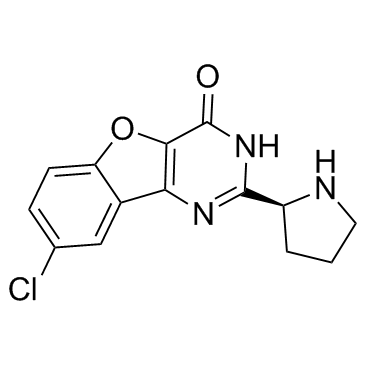XL413
Modify Date: 2024-01-19 19:53:45

XL413 structure
|
Common Name | XL413 | ||
|---|---|---|---|---|
| CAS Number | 1169558-38-6 | Molecular Weight | 289.71700 | |
| Density | N/A | Boiling Point | N/A | |
| Molecular Formula | C14H12ClN3O2 | Melting Point | N/A | |
| MSDS | N/A | Flash Point | N/A | |
Use of XL413XL413 is a potent, selective and ATP competitive inhibitor of Cdc7, with an IC50 of 3.4 nM, and also shows potent effect with IC50s of 215, 42 nM on CK2, PIM1, respectively, and an EC50 of 118 nM on pMCM. |
| Name | 8-chloro-2-[(2S)-pyrrolidin-2-yl]-1H-[1]benzofuro[3,2-d]pyrimidin-4-one |
|---|---|
| Synonym | More Synonyms |
| Description | XL413 is a potent, selective and ATP competitive inhibitor of Cdc7, with an IC50 of 3.4 nM, and also shows potent effect with IC50s of 215, 42 nM on CK2, PIM1, respectively, and an EC50 of 118 nM on pMCM. |
|---|---|
| Related Catalog | |
| Target |
Cdc7:3.4 nM (IC50) PIM1:42 nM (IC50) CK2:215 nM (IC50) |
| In Vitro | XL413 inhibits the cell proliferation (IC50 = 2685 nM), decreases cell viability (IC50 = 2142 nM) and elicits the caspase 3/7 activity (EC50 = 2288 nM) in Colo-205 cells. XL413 also significantly inhibits the anchorage-independent growth of colo-205 in soft agar (IC50 = 715 nM)[1]. XL413 shows cytotoxic effects on tumors, with IC50 of 22.9 µM in HCC1954 cells and 1.1 µM in Colo-205 cells. XL413 induces apoptosis in the Colo-205 cells, but not in HCC1954 cells. XL413 is effective DDK inhibitors in vitro, with IC50 of 22.7 nM. XL413 is defective in inhibiting DDK-dependent Mcm2 phosphorylation in HCC1954 cells but is effective in Colo-205 cells[2]. |
| In Vivo | XL413 (100 mg/kg, p.o.) shows excellent plasma exposures in mice and possesses good PK properties. XL413 (10, 30, or 100 mg/kg, p.o.) is well tolerated at all the doses, with no significant body weight loss[1]. |
| Kinase Assay | 20 ng of purified human DDK is pre-incubated with increasing concentrations of each DDK inhibitor for 5 min. Then 10 µCi (γ)-32P ATP and 1.5 µM cold ATP are added in a buffer containing 50 mM Tris-HCl (pH 7.5), 10 mM MgCl2, and 1 mM DTT and incubated for 30 min at 30°C. The proteins are denatured in 1X Laemmli buffer at 100°C followed by SDS-PAGE and autoradiography on HyBlot CL film. Auto-phosphorylation of DDK is used as an indicator of its kinase activity. 32P-labeled bands are quantified using ImageJ and the IC50 values are calculated using GraphPad. |
| Cell Assay | For assays in 96 well plates 2500 cells are plated per well. After 24 hours, cells are treated with small molecule inhibitors and incubated for 72 hours at 37°C. Subsequently the cells are lysed and the ATP content is measured as an indicator of metabolically active cells using the CellTiter-Glo assay. IC50 values are calculated using the GraphPad software. For assays in six well plates, 100,000 cells are plated per well. After 24 hours, cells are treated with small molecule inhibitors and incubated for varying time points. Cells are trypsinized and a suspension is made in 5 mL of phosphate buffered saline. 30 µL of this suspension is mixed with 30 µL of CellTiter-Glo reagent followed by a 10-minute incubation at room temperature. Luminescence is measured using EnVision 2104 Multilabel Reader and BioTek Synergy Neo Microplate Reader. |
| References |
| Molecular Formula | C14H12ClN3O2 |
|---|---|
| Molecular Weight | 289.71700 |
| Exact Mass | 289.06200 |
| PSA | 71.18000 |
| LogP | 3.48830 |
| Storage condition | 2-8℃ |
| 0SX |
| Benzofuro(3,2-d)pyrimidin-4(3H)-one,8-chloro-2-((2S)-2-pyrrolidinyl) |
| UNII-8QK62S7492 |
| 8-Chloro-2-[(2s)-Pyrrolidin-2-Yl][1]benzofuro[3,2-D]pyrimidin-4(3h)-One |
| (S)-8-chloro-2-(pyrrolidin-2-yl)benzofuro[3,2-d]pyrimidin-4(3H)-one |
| XL413 |